Arm Announces Neoverse N1 & E1 Platforms & CPUs: Enabling A Huge Jump In Infrastructure Performance
by Andrei Frumusanu on February 20, 2019 9:00 AM ESTFirst N1 Silicon: Enabling the Ecosystem with SDPs
A little known fact about Arm is that the company designs its own silicon test platform – actually deploying them on development board to enable validation and software development on hardware that Arm and developers have full control of. The latest generation was the Juno platform, which in its first revision started off with a Cortex A57 and served as the fundamental silicon testbed for ARMv8 software.
Ever since Arm started the programme in 2014, Arm has shipped over 1400 boards both internally and to its partners. The amount of chips we’re talking about here sounds paltry, however we have to keep in mind we’re talking about very limited shuttle runs on MPW (multi-project wafers) where Arm shares wafer space with numerous other companies.
For today’s announcement, Arm had the pleasure to reveal that it received back the first working Neoverse N1 silicon back in December – with the chips meant to be integrated into the new Neoverse System Development Platform (SDP).
The N1 SDP represents major step for Arm as it not only is the first silicon to come back with the N1 CPU, but also is Arm’s first own 7nm silicon. The platform represents a major proof of concept of the IP, as well as interoperability with third-party IP, employing a lot of the peripheral IP such as PCIe and DDR PHY supplied by Cadence.
The actual hardware is a limited implementation of an N1 SoC – we find a 4-core N1 CPU with 1MB L2 configuration in the form of 2xMP2 connected to a CMN-600 with an 8MB SLC setup.
The board includes a CCIX compatible PCIe 4.0 x16 slot which serves the crucial role of enabling development and demonstrating cache-coherent integration with CCIX hardware such as Xilinx’s FPGA.
The N1 SoC actually doesn’t contain dedicated I/O IP, rather Arm implements all connectivity via a dedicated FPGA which serves as the I/O hub, supporting various connectivity options such as Ethernet, USB, SATA and so on.
Naturally the big selling point of the SDP is its completely open-source firmware stack from not only the OS drivers, but more importantly the SCP and MCP firmware.
An important new feature that is first employed by the new N1 CPU is the introduction of statistical profiling extensions (SPE). The new extension enables the first ever self-hosted profiling capability in an Arm CPU – meaning we don’t require a separate CPU or system having to read out microarchitectural counters. Instead the new SPE can be configured to directly write this information into memory. The tool is extremely useful for tracing code and analysing core behaviour, identifying possible performance issues and further squeezing out the maximum performance out of a platform, something Arm is taking very seriously if it wants to succeed and gain adoption in HPC.
Finally, the N1 SDP will be available later this quarter – although don’t expect the board to be easily attainable for the average user.


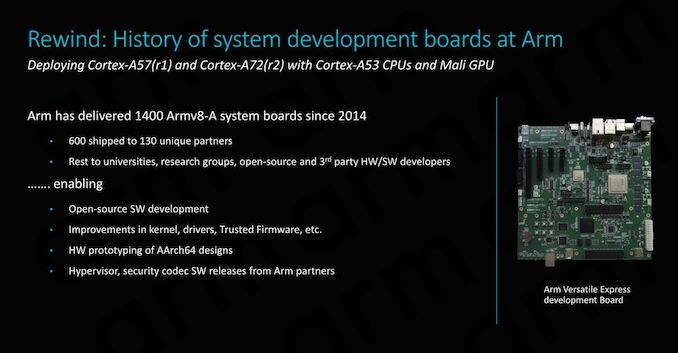
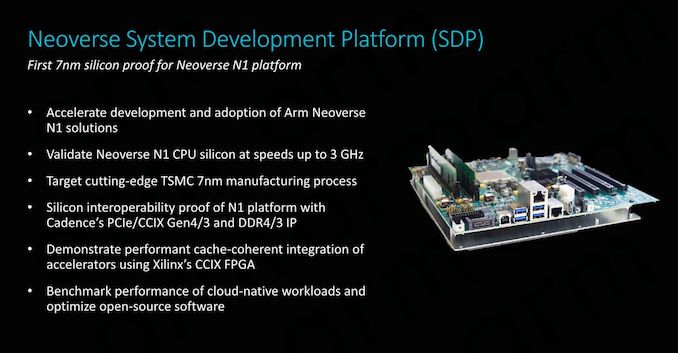
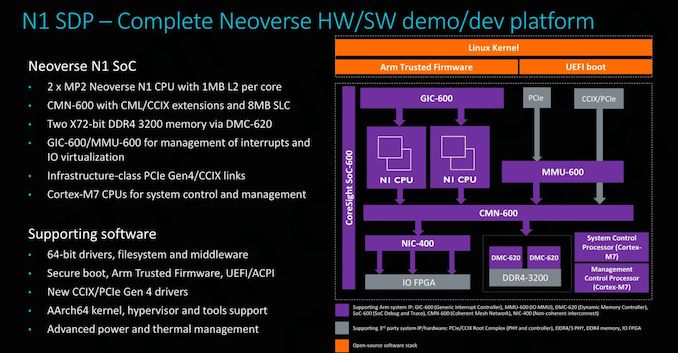
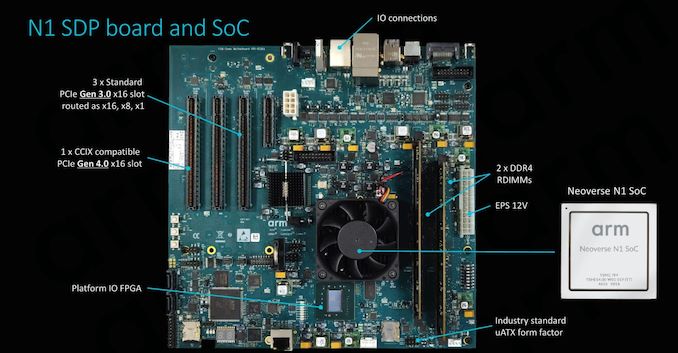

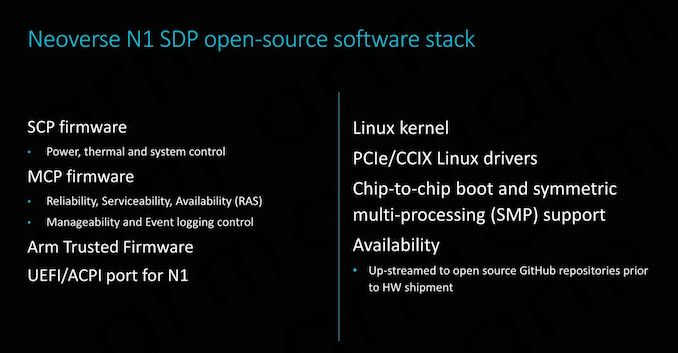

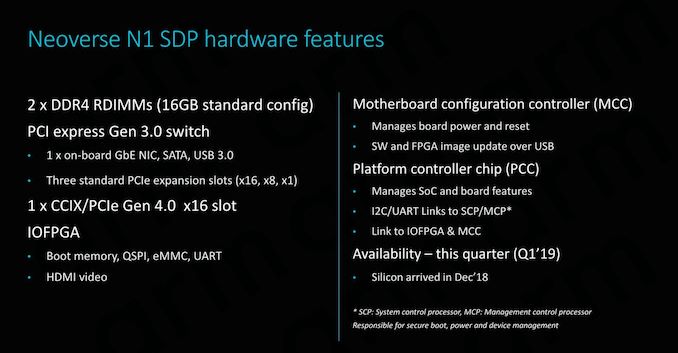








101 Comments
View All Comments
eastcoast_pete - Thursday, February 21, 2019 - link
I stand corrected on IBM still selling x86 servers (they don't), and am actually glad to hear that Power is also used in smaller shops. It's just that I haven't run into too many Power systems around here. It's a very capable arch.Kevin G - Thursday, February 21, 2019 - link
The big Power users are also the big cloud providers. Google and Amazon have reportedly taken a liking to openPower hardware. Facebook has reportedly looking into openPower as well. Granted this are small scale compared to the number of x86 systems these companies have, it was a much need shot of energy into the Power platform.nevcairiel - Wednesday, February 20, 2019 - link
Microsoft already ported Windows Server to ARM, and their entire development stack has support for ARM and ARM64 now, so its only a matter of time for the other server products to be made available.HStewart - Wednesday, February 20, 2019 - link
It really funny that Microsoft did not trust that environment enough to created Surface using ARM processor.GreenReaper - Wednesday, February 20, 2019 - link
Uh . . . that's reportedly because Intel came begging them *not* to for the Surface Go 2018 (and probably cut them a very nice deal on the Pentium Gold as a result): https://www.techradar.com/uk/news/microsoft-surfac...As mentioned, you can also compile for 64-bit ARM in VS now. This is a major win for some apps which truly require native execution (which is not all of them, but enough to be a pain):
https://blogs.windows.com/buildingapps/2018/11/15/...
Will it actually become a viable platform as a result of all this? I suspect it still won't be the default in five years, but in cost-conscious areas it could end up with a foothold. Even if Microsoft doesn't go down that route, it may be open for others to do so for specific purposes, such as education.
eastcoast_pete - Wednesday, February 20, 2019 - link
Not funny; rather, cautious. None of the A76 designs were in silico when MS designed the current Surface. When you specc out a design like the Surface, you base it on what's available at that time, not what might be around next year. Otherwise, the chance of ending up with egg on one's face is uncomfortably high.eastcoast_pete - Wednesday, February 20, 2019 - link
I agree with you, but, as we all know, businesses buy the hardware that can run the software they want or need, not the other way around. In this regard, I am curious if Oracle and SAP are porting their offerings to ARM64 server. If both of those are on board, this design would have a great chance to get strong traction.HStewart - Wednesday, February 20, 2019 - link
One thing that I am concern in this article is that this chip is mark as Simulated in charts which to me is just a marketing term. Also it comparing again existing 2018 designs for both Intel and AMD. An actual fair comparison with Sunny Cove based cpu with more units and such.I also think that just increase cores is not the best way to handle performance, in todays world single core performance is still very important but this depends on the market the chip is intended for but the important part is software compatibility.
Antony Newman - Wednesday, February 20, 2019 - link
H.A Simulated vs Historical point was made in the article. Perhaps you need to reread?
Also : Single Core performance is very important - especially when they are all running flat out.
Intel has to throttle down their multi core beasts so the chips don’t catch fire at 14nm.
At 10nm - Intel will be able to sustain a few more cores before throttling.
And before Intel are at (Intel) 7nm, ARM will likely overtake Intel on the IPC front (assuming that ARM’s ‘prediction is as accurate as my own)
AJ
eastcoast_pete - Wednesday, February 20, 2019 - link
Single core is still important for client computers, but much less so for servers.